You’ve probably heard the word D-Day being used with reference to a past war or major battle. We even use it colloquially today when we know it’s the final day to take action. For example, if you have a major deadline at work, you may say to your team, “today is D-Day,” but do you know exactly what this means and the significance around it? Let’s find out.
D-Day facts are fascinating, even more than 50 years after the D-Day invasion took place, there are still so many interesting things about the tragic day being uncovered that are very interesting.
We’ve gathered interesting facts about the day June 6th, 1944, when the large-scale invasion of Normandy, France took place and changed the course of World War II. D-Day is seen as the turning point in World War II, one that dictated the rest of the war.
38 Interesting Facts about D Day
Military historians, and many people for that matter, are interested in facts about the D-Day invasion. There are many reasons for this but the sheer scale of the invasion seems to be the biggest fascination. The soldiers who lost their lives on the beaches of Normandy did not do so in vain, as D-Day marked the beginning of the Allies retaking Europe.
Here are 38 interesting d day facts.
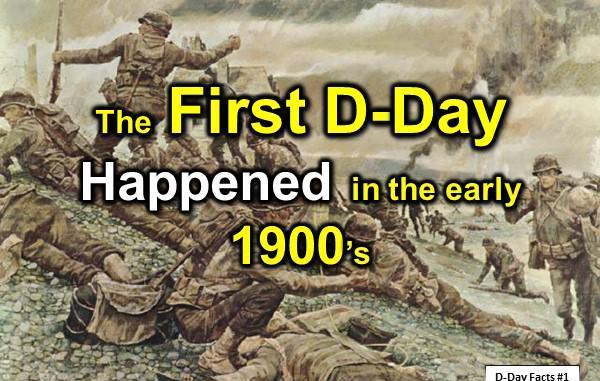
1. The D-Day invasion took place in a coastal area of France, known as Normandy, and changed the landscape and history of the area. The region has a rich history but despite this, it’s now most famously remembered as the scene of this bloody invasion.
2. The term D-Day is a generic term that has been used by the military since the early 1900s. It describes the date a combat operation will take place.
3. Many people have the misconception that D-Day stands for something. Some considered variations are doomsday, designated day, decision day, and even death day.
However, military historians have determined that the D is merely the coded designation for ‘day’. They also determined that days before and after D-Day were marked with plus and minus signs. D+6 meant six days after D-Day and D-3 meant three days before D-Day.

4. The First D-Day Happened in the early 1900s. The impact and monumental nature of the Allied invasion of Normandy on June 6th, 1944, made it legendary – and ultimately, the day in history that we all know today as D-Day.
5. This amphibious invasion is the largest in history, allied forces on water, air, and land invaded the Nazi-occupied coast of Normandy. The forces battled German gunfire and high casualties and ultimately won the battle. This contributed to turning the tide of World War II towards the defeat of Hitler’s forces.
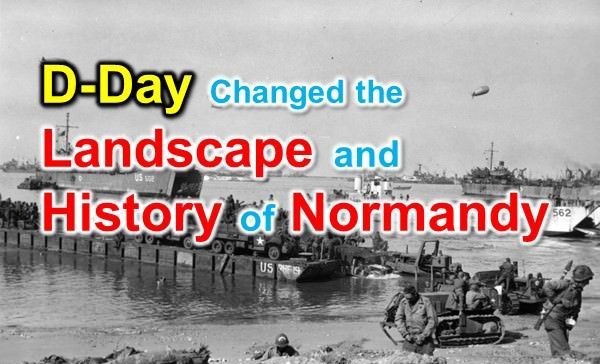
6. D-Day was meant to have happened a day earlier on June 5th, 1944. However, because of bad weather on this day, it was decided that the D-Day invasion would take place the following day, on June 6th.
7. The weather had other detrimental effects. In addition to delaying the D-Day invasion by one day, it blew the Allies’ boats east of their planned landing targets. This was especially true for the Omaha and Utah beach landing targets.
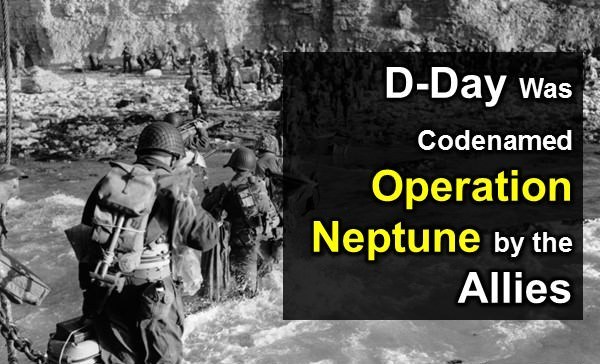
8. D-Day was codenamed Operation Neptune by the Allies. Neptune is the Greek god of the sea. It’s, therefore, a fitting name, considering the invasion was launched from the sea.

9. German troops didn’t leave Normandy and its surrounding islands until mid-1945. Although the Allies successfully invaded Normandy on D-Day, it was nearly a year later, on May 9th, 1945, that the entire German occupation of Normandy, including the surrounding islands, ended.
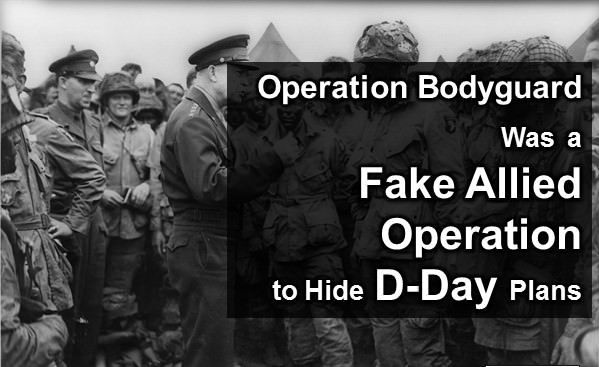
10. Operation Bodyguard was a fake Allied operation to hide the plans about D-Day. In an attempt to deceive the Germans, the Allies created the fictitious Operation Bodyguard. This way, the Germans would be unsure of the exact date and location of the main Allied landings.

11. There were multiple fake D-Day plans and operations designed to deceive the German troops. These included fake operations with great detail about attacks to the north and south of the actual beach landing points in Normandy. Interestingly, some efforts were even made to make the Germans think that the attack would take place in Norway.
12. Before D-Day, Normandy was a tourist and resort area. The beaches of Normandy were a popular coastal destination for tourists to the Atlantic coast before World War II.
From the 1800s Normandy has been a popular seaside tourist area and with its natural beauty, it’s not hard to see why. There are still many beautiful beach towns and resorts on the Normandy coast that are visited today.
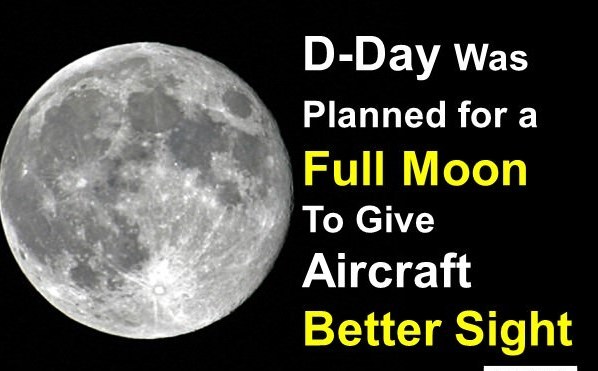
13. D-Day was planned for a full moon. The Allies wanted the light of the full moon to provide better sight for their aircraft. In addition, they also wanted to have one of the highest tides. The invasion was carefully planned and scheduled to land partway between low tide and high tide, with the tide coming in.
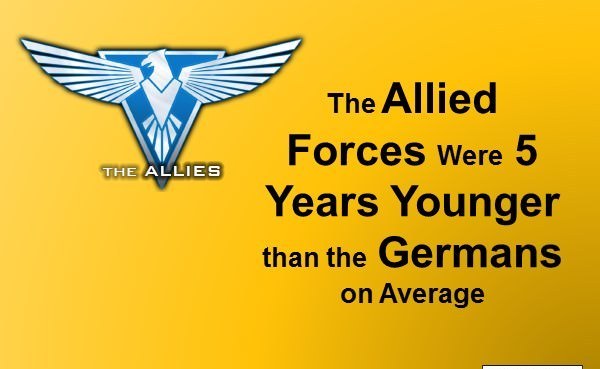
14. D-Day was the largest multinational invasion in history. The multinational effort had many countries involved. The Allied forces invading Normandy included troops primarily from the United States, Britain, Canada, Poland, and France.
But they also had ground, air, and naval support from Australia, Belgium, Greece, New Zealand, the Netherlands, Zimbabwe, and Norway.
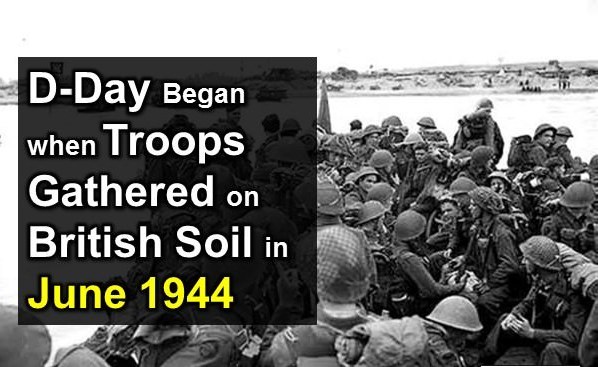
15. The allied forces were five years younger than the Germans on average. Due to heavy losses and casualties on the Eastern Front, the German forces no longer had a large population of young men to enlist.
16. Between 1942 and 1944, about 1 million US troops arrived in the UK in preparation for D-Day. And by the day of the invasion, the United States had shipped around 7 million tonnes of supplies to the United Kingdom.
17. These US soldiers earned a solid salary of around £12 ($16) a month. This made them very popular amongst women living in Britain and resulted in 70,000 marriages between American servicemen and British women.

18. D-Day began when Allied troops gathered on British soil in June 1944. Many D-Day facts focus on Normandy, as this is where the Allies landed. But a commonly asked question is “where did the Allies launch their invasion?”.
The Normandy landings (also known as the D-Day invasion) were conducted from across the English Channel, with troops first gathering on British soil before launching the attack on that fateful day in June 1944.
19. Prior to the invasion, Royal engineers were deployed in midget submarines in order to conduct secret assessments of the beaches. They even collected sand samples.
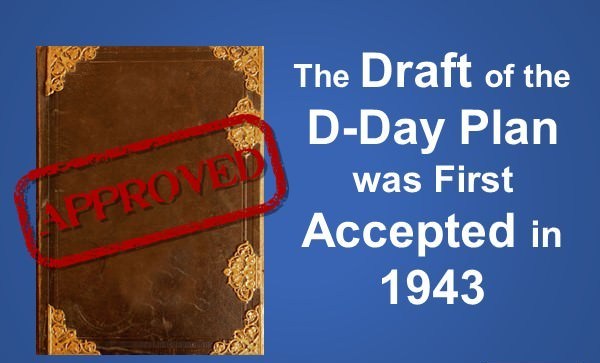
20. The D-Day invasion, codenamed Operation Neptune, was the first part of a larger plan to take the European continent back from the Germans who occupied it. Operation Overlord was the name given to the large-scale plan, and Operation Neptune was the first phase of the plan.

21. The first draft of the D-Day plan was accepted in 1943. Intricate planning for the D-Day invasion actually began long before the event took place. Historical D-Day facts reveal that an initial draft of the invasion plan was accepted at a conference in August 1943.
22. All information and plans pertaining to the D-Day invasion were marked “Bigot”. This was a classification even more confidential than “Top Secret”. There were also an estimated 17 million maps drawn up during the planning and preparation of the invasion.
23. To ensure his men didn’t let out any secrets about D-Day, British Commander Terence Otway devised a plan to test them. He organized 30 members of the Women’s Auxiliary Air Force, to visit a pub near where the soldiers were training, in plain clothes.
They were instructed to do everything they could to discover the mission, however, none of the men gave away anything.

21. The first draft of the D-Day plan was accepted in 1943. Intricate planning for the D-Day invasion actually began long before the event took place. Historical D-Day facts reveal that an initial draft of the invasion plan was accepted at a conference in August 1943.
22. All information and plans pertaining to the D-Day invasion were marked “Bigot”. This was a classification even more confidential than “Top Secret”. There were also an estimated 17 million maps drawn up during the planning and preparation of the invasion.
23. To ensure his men didn’t let out any secrets about D-Day, British Commander Terence Otway devised a plan to test them. He organized 30 members of the Women’s Auxiliary Air Force, to visit a pub near where the soldiers were training, in plain clothes.
They were instructed to do everything they could to discover the mission, however, none of the men gave away anything.
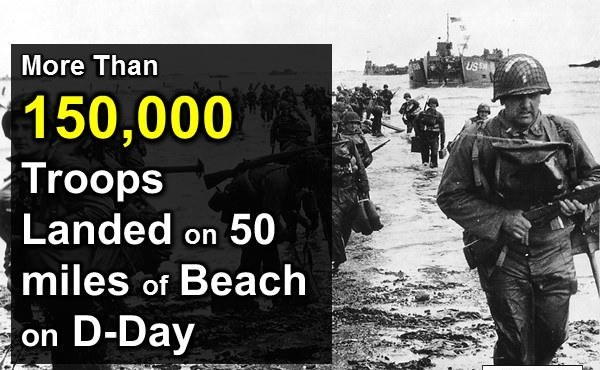
26. Eisenhower was also the Commander in Chief of Operation Overlord (the large-scale plan to retake Europe).
27. Eisenhower actually threatened to quit just a few months before D-Day. He suggested diverting Allied bombers to instead start bombing critical Nazi-occupied French infrastructure.
Churchill and others did not see this as a good idea and were worried about collateral damage to France, one of their biggest allies. Facing this opposition, Eisenhower threatened to step down, however, he never did and D-Day went ahead as planned.
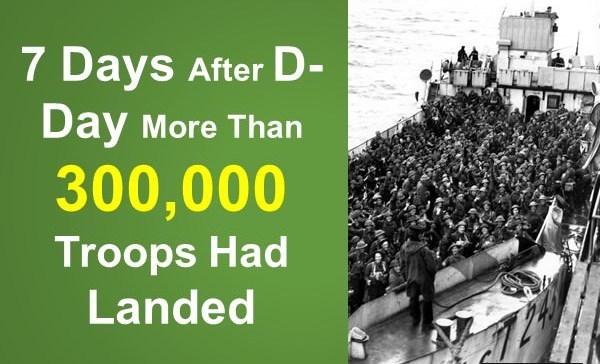
28. D-Day was the largest invasion and attack by the sea in history. Montgomery Eisenhower reviewed the initial plans for D-Day and decided that a larger-scale invasion was necessary.
The goal of the Allies was to allow operations and troops to move quickly and to capture ports that were strategic. This was all part of the overall plan to retake the European continent.
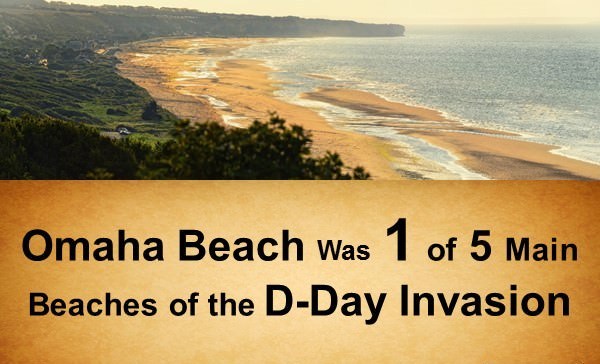
29. D-Day was one of the largest single military operations of all time with more than 150,000 troops landing on five beaches on a 50 mile stretch of land. It may be this epic scale of the D-Day invasion that explains just why people are so fascinated by D-Day facts.

30. The first set of troops landing in the occupied area signaled only the beginning of the invasion. Just seven days after D-Day more than 300,000 troops had landed in Normandy and the beaches where they had landed were fully under their control.
By that time, in addition to the troops, there were 50,000 vehicles, and over 100,000 tons of equipment brought through the beaches of Normandy.

31. By the end of June 1944, the Allies had brought over 850,000 troops through the beaches of Normandy and the ports that had been opened up as a result of the D-Day invasion.
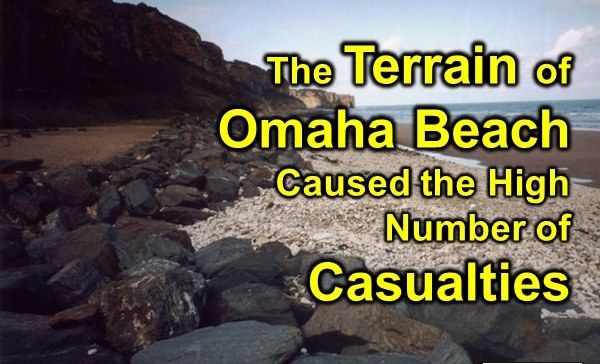
32. Omaha Beach was one of the five main beaches of the D-Day invasion. The Allies divided the 50 miles of the Normandy coast into five sections, which ultimately became beaches. The beaches at Normandy were named by the troops as Utah, Omaha, Gold, Juno, and Sword.

33. The most successful beach landing was on Utah beach. Of the 20,000 men put ashore, there were only 300 casualties.
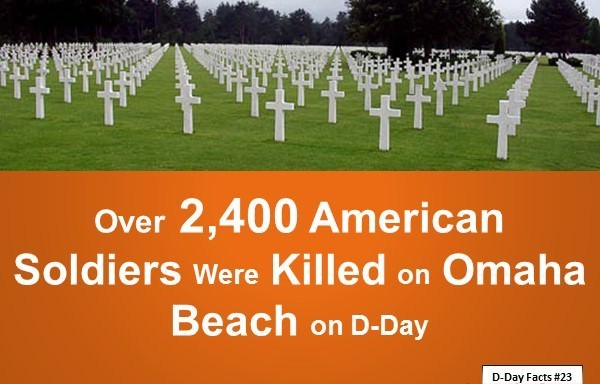
34. Omaha Beach was where the Allies suffered the most losses and casualties. The geography and landscape of the area played a role in this. High cliffs lining the beach characterized the area of the Omaha Beach landing target.
Many American forces and troops lost their lives because the Germans had gun positions on these high cliffs.

36. Over 2,400 American soldiers were killed on Omaha Beach on D-Day. This was due to the geography of Omaha Beach, and the weather that had blown the ships off their target.
The weather also led to the sinking of some tanks intended to provide support for the troops landing at Omaha Beach. The high number of casualties was also, in part, due to the lack of artillery providing reinforcements for the troops.

37. Due to their positions, the Germans suffered fewer casualties than the invading Allied troops at Normandy. German casualties were estimated to be between 4000 and 9000.
However, the Germans had no reinforcements to help them retake positions. Once the Allies had landed at Normandy, they took control of the beaches and ports and continued until all of Europe was free.
38. The only person who could order German Panzers to counter-attack the Allied invasion on D-Day was Hitler but he happened to sleep till midday on June 6, 1994.

Final Thoughts on D-Day Facts
The magnitude and scale of the D-Day invasion and its significant role in World War II make D-Day facts fascinating, even today. It was a tragic day, where many troops lost their lives fighting in Normandy on June 6th, 1944.
The Normandy landings were codenamed Operation Overlord and set in motion the larger plan to retake Europe. Had the D-Day invasion not been a success, the result of World War II could have been very different.
Thankfully, despite a heavy loss of life, the Allies were ultimately successful in taking the beaches of Normandy and retaking Europe, which also resulted in the start of a victory over Hitler’s forces. This was a major win for the Allies and the world. I hope you enjoyed reading these facts about d-day.
If you’re a history buff interested in fascinating information about major battles, these facts about the Battle of Hastings will be sure to intrigue you and facts about the Vietnam War as well as Facts about the Holocaust.



Steve Fox
Friday 15th of October 2021
Many people wrongly like to say that D-day was the turning point of the war in Europe, for WW2. Which is wrong. But the the time D-day came around, the Germans have been in full retreat from Russian forces, for almost a year. A more accurate state would be that the battle of Stalingrad was the turning point of the European theater, of WW2.
Amanda O'Brien
Friday 15th of October 2021
Thanks for sharing your perspective Steve. cheers Amanda